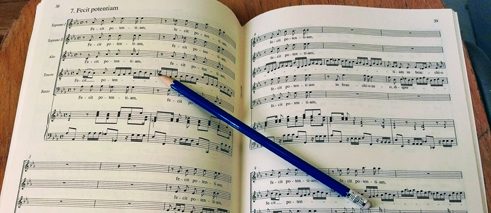Learning Curve
Berlin
Four weeks into an intensive language course with the Goethe Institut in Berlin I faced my greatest learning curve so far: a music rehearsal entirely in German. Humiliation seemed inevitable. Someone would speak to me in German and I’d have to speak back. Even if I could navigate social pleasantries, how much of the rehearsal process would I comprehend in a foreign language?
I arrived at an open rehearsal with the Berlin Philharmonie Chor with huge anxiety. Experience singing in German has provided a significant head start in comprehension and pronunciation. But the act of speaking – of forming and expressing thoughts, questions and responses under pressure – is my biggest learning curve. Spontaneous conversation is therefore a deeply uncomfortable prospect.
I mumbled my way through music allocations and small talk about the weather before retreating to study of the score. Naturally, in the hope no one would speak to me. And because sight reading coloratura is hard. I had no idea what to expect: would I understand what the conductor was asking of us?
 Bach's Magnifikat | © Imogen Thirlwall
Rehearsing with a German speaking choir was a calculated decision – that old trick, “throw yourself into a fear-inducing situation to see what happens”. An exercise in learning what you don’t know. But there is also relative safety in singing with others, reading collective body language, and being able to listen and respond with physical action rather than needing to find words.
Bach's Magnifikat | © Imogen Thirlwall
Rehearsing with a German speaking choir was a calculated decision – that old trick, “throw yourself into a fear-inducing situation to see what happens”. An exercise in learning what you don’t know. But there is also relative safety in singing with others, reading collective body language, and being able to listen and respond with physical action rather than needing to find words.
I did not understand every instruction, joke or musing. Sometimes, you just have to smile and nod.
 Learning from Studio 21 | © Imogen Thirlwall
Of importance: numbers! As the rehearsal process is driven by correcting mistakes and cementing musical interpretation, Takt (bar) numbers will be called out in fast succession. Key words: noch mal (again), schneller (faster), leichter (lighter), ohne Sopran (without soprano...a good one to get right!).
Learning from Studio 21 | © Imogen Thirlwall
Of importance: numbers! As the rehearsal process is driven by correcting mistakes and cementing musical interpretation, Takt (bar) numbers will be called out in fast succession. Key words: noch mal (again), schneller (faster), leichter (lighter), ohne Sopran (without soprano...a good one to get right!).
Body language, tone and physical gesture serves language comprehension, and when you make music, this is amplified. Word-driven explanations spoken at lightening pace can be overwhelming. But conductors expertly use their bodies to show you what they want. One of my favorite universal teaching strategies is demonstration. A conductor will vocalise musical lines in different ways and use negations (nicht, kein) to show you their musical interpretation. With just a few words, the musical intention is simple to understand.
 Winter Christmas markets | © Imogen Thirlwall
The next challenge: singing German Christmas carols at a nursing home with a promise to myself to make spontaneous conversation. From wintery Berlin ahead of my first Christmas away from home, here’s a tune.
Winter Christmas markets | © Imogen Thirlwall
The next challenge: singing German Christmas carols at a nursing home with a promise to myself to make spontaneous conversation. From wintery Berlin ahead of my first Christmas away from home, here’s a tune.
